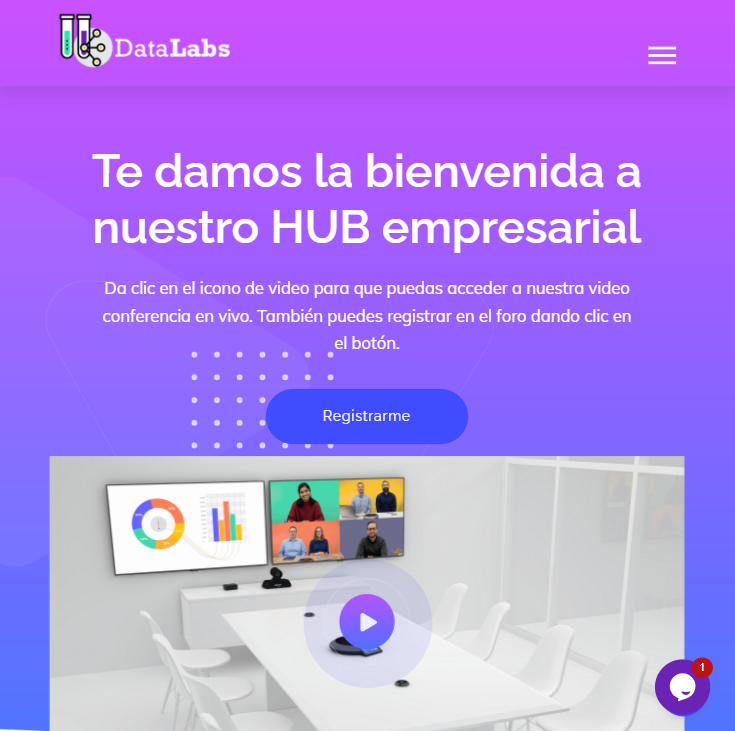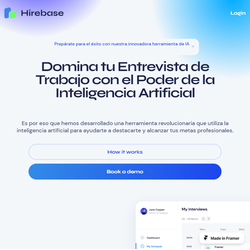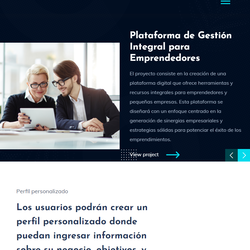Data sheet
| 💸 Inversión Aprox. | 15000 |
More info
Digital Structure
These platforms are especially useful for virtual meetings, webinars, webinars, and online conferences. Below I provide an overview of the common features found on these platforms:
- Event Scheduling: Allows organizers to create events, set dates and times, and schedule online digital conferences.
- Participant Registration: Attendees can register for the event by providing their contact information. Organizers may collect demographic and contact data from participants.
- Access and authentication: Participants typically receive links or invitations to access the conference. They may require authentication to ensure that only registered individuals have access.
- Presentation and screen sharing: Presenters can share their screen to display presentations, documents, videos and other multimedia content.
- Real-time communication: They offer live chat tools, questions and answers, polls and comment options to encourage interaction between presenters and participants.
- Recording and storage: Many platforms allow conferences to be recorded so that participants can access them later. These recordings are usually stored in the cloud.
- Integration with external tools: They can be integrated with other applications and tools such as learning management systems (LMS), event management systems, CRM systems and more.
- Participant Management: Organizers can manage the participant list, send email reminders, and manage attendance.
- Analytics and statistics: Provide data on attendance, participant interaction and other analytics to measure the success of the event.
- Security and privacy: They must have security measures to protect the privacy of participants and avoid security problems.
Some of the popular digital conferencing platforms include Zoom, Microsoft Teams, Google Meet, GoToWebinar, Webex, among others. Choosing a platform depends on your specific needs and the size of your audience. Be sure to do your research and compare the features before choosing the one that best suits your situation.
Landing Page
Conferencia HUB
Reference: #CONFERENCEHUB
🌱 Capital: Accelerator
A digital conferencing web platform is an online system that allows people to organize, participate in and manage online conferences, presentations or events over the Internet.
Una plataforma web de conferencias digitales es un sistema en línea que permite a las personas organizar, participar y gestionar conferencias, presentaciones o eventos en línea a través de Internet.
8 other products in the same category:
P&Rs
-
¿Qué es un proyecto digital?
Un proyecto digital es una iniciativa que utiliza tecnologías digitales para alcanzar un objetivo específico. Esto puede incluir el desarrollo y la implementación de plataformas, aplicaciones, sitios web, campañas de marketing digital, sistemas de gestión de información, y más. Los proyectos digitales se caracterizan por su uso de herramientas y recursos tecnológicos para mejorar procesos, servicios, o productos, y pueden aplicarse en diversos sectores como la educación, la salud, el comercio, y la comunicación.
Los objetivos comunes de un proyecto digital pueden ser:
1. Mejorar la Eficiencia: Automatizar y optimizar procesos para ahorrar tiempo y recursos.
2. Incrementar la Visibilidad: Utilizar el marketing digital para llegar a una audiencia más amplia y aumentar la presencia en línea.3. Fomentar la Innovación: Desarrollar nuevas tecnologías o mejorar las existentes para ofrecer mejores servicios o productos.
4. Facilitar el Acceso a la Información: Crear plataformas que permitan un acceso más fácil y rápido a datos y recursos importantes.
5. Mejorar la Experiencia del Usuario: Diseñar interfaces y servicios que sean más intuitivos y agradables para los usuarios.
-
¿Qué es un hub digital?
Un hub digital es una plataforma centralizada que integra y coordina diversas herramientas, recursos y servicios digitales en un único punto de acceso. Su objetivo es facilitar la gestión, el intercambio y la colaboración de información digital dentro de una organización o entre múltiples partes interesadas.
Los beneficios de un hub digital incluyen:
1. Centralización de Recursos: Agrupa diversas herramientas y recursos digitales en un solo lugar, lo que facilita el acceso y la gestión de la información.
2. Mejora de la Colaboración: Permite a equipos y departamentos trabajar juntos de manera más efectiva, compartiendo información y recursos en tiempo real.
3. Eficiencia Operativa: Reduce la duplicación de esfuerzos y mejora la eficiencia operativa al tener todos los recursos necesarios accesibles desde un único punto.
4. Acceso Simplificado: Facilita el acceso a información y herramientas, reduciendo el tiempo y esfuerzo necesarios para buscar y utilizar distintos recursos digitales.
5. Flexibilidad y Escalabilidad: Permite una fácil adaptación a las necesidades cambiantes de la organización, pudiendo integrar nuevas herramientas y servicios según sea necesario.














